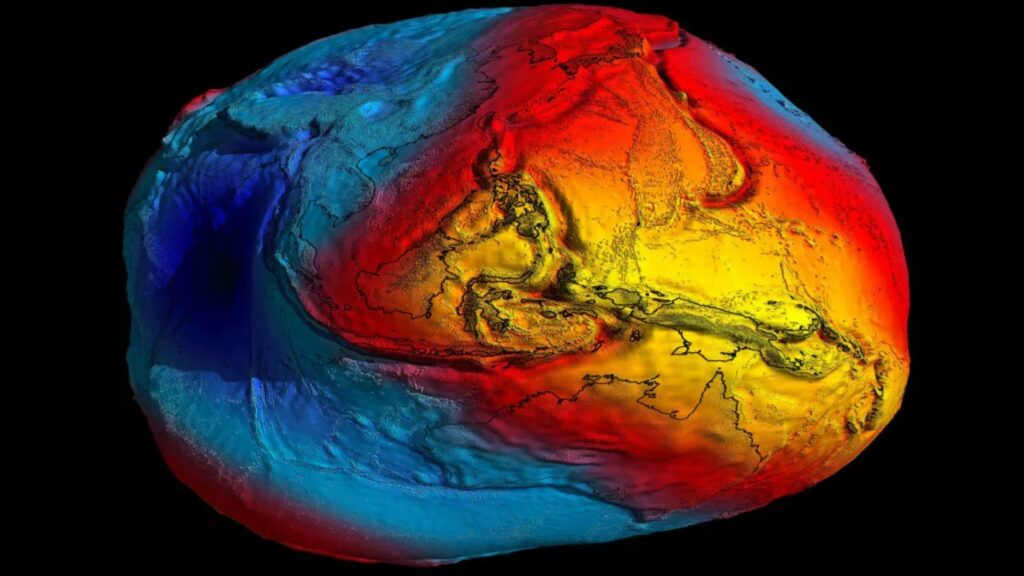Scientists attribute the Indian Ocean’s gravity anomaly to a prehistoric ocean that no longer exists
Scientists have puzzled over the origins of a gravity hole in the Indian Ocean for years. Now, researchers think the sunken floor of an extinct ocean could be the cause.
Scientists may have made a breakthrough in unraveling the enigma behind a deep “gravity hole” situated in the Indian Ocean, where the gravitational force is notably weaker compared to other regions on Earth.

Known as the Indian Ocean geoid low (IOGL), this depression spans an area of 1.2 million square miles (3 million square kilometers) and is located 746 miles (1,200 kilometers) southwest of India. The IOGL exhibits such feeble gravitational pull that it has resulted in the displacement of water, causing the sea level over the depression to be 348 feet (106 meters) lower than the global average.
The existence of this low is linked to the peculiar nature of our planet, which is relatively malleable, flattening at the poles, bulging at the equator, and exhibiting undulations across its surface. However, since its discovery in 1948, the origin of this abyss in the Indian Ocean has perplexed scientists.
In a study recently published on May 5 in the journal Geophysical Research Letters, a possible explanation has emerged for the Indian Ocean geoid low (IOGL). The study proposes that this gravity anomaly was caused by the intrusion of low-density magma, which was pushed into the Indian Ocean by sinking slabs from an ancient ocean.
The researchers acknowledged the enigmatic nature of the IOGL’s origin, stating that previous theories focused on the present-day anomaly without delving into its formation. Seeking answers, they employed 19 computer models to simulate the movements of the mantle and tectonic plates in the region spanning 140 million years. By comparing the simulated depressions generated in each model with the actual observed geoid low, they made significant findings.
Among the models, six demonstrated the closest resemblance to the real geoid low. These models shared a common characteristic: the presence of plumes comprising hot, low-density magma that rose to displace the higher-density material beneath the low. This displacement reduced the region’s overall mass, consequently weakening its gravitational pull.
The identified plumes originated from a disturbance located approximately 600 miles (1,000 km) west beneath Africa. Referred to as the “African blob,” this dense accumulation of crystallized material within Africa’s mantle spans the size of a continent and towers 100 times higher than Mount Everest.
The question arises: What could have driven the movement of the crystallized material beneath the Indian Ocean? The missing pieces of the tectonic puzzle come in the form of “Tethyan slabs,” remnants of the ancient Tethys Ocean that existed over 200 million years ago between the supercontinents Laurasia and Gondwana.
The researchers propose a scenario where, after the Indian plate separated from Gondwana and collided with the Eurasian plate, it traversed over the Tethys plate, resulting in the subduction of the Tethys plate under the Indian plate. As the Tethys plate was pushed into the mantle near present-day East Africa, fragments of the ancient Tethys Ocean began to gradually sink deeper into the lower mantle. Eventually, approximately 20 million years ago, these sinking Tethyan plates displaced some of the trapped magma within the African blob, leading to the formation of the identified plumes.
The researchers assert that these plumes, along with the specific mantle structure surrounding the geoid low, contribute to the development of this negative gravity anomaly. To confirm these predictions, scientists will need to gather earthquake data from the vicinity of the geoid low to determine the existence of the plumes. Whether the plumes provide the complete explanation or if deeper forces are also involved remains a subject for further investigation.
Do not forget to share your opinion with us to provide you with the best posts !




0 Comments